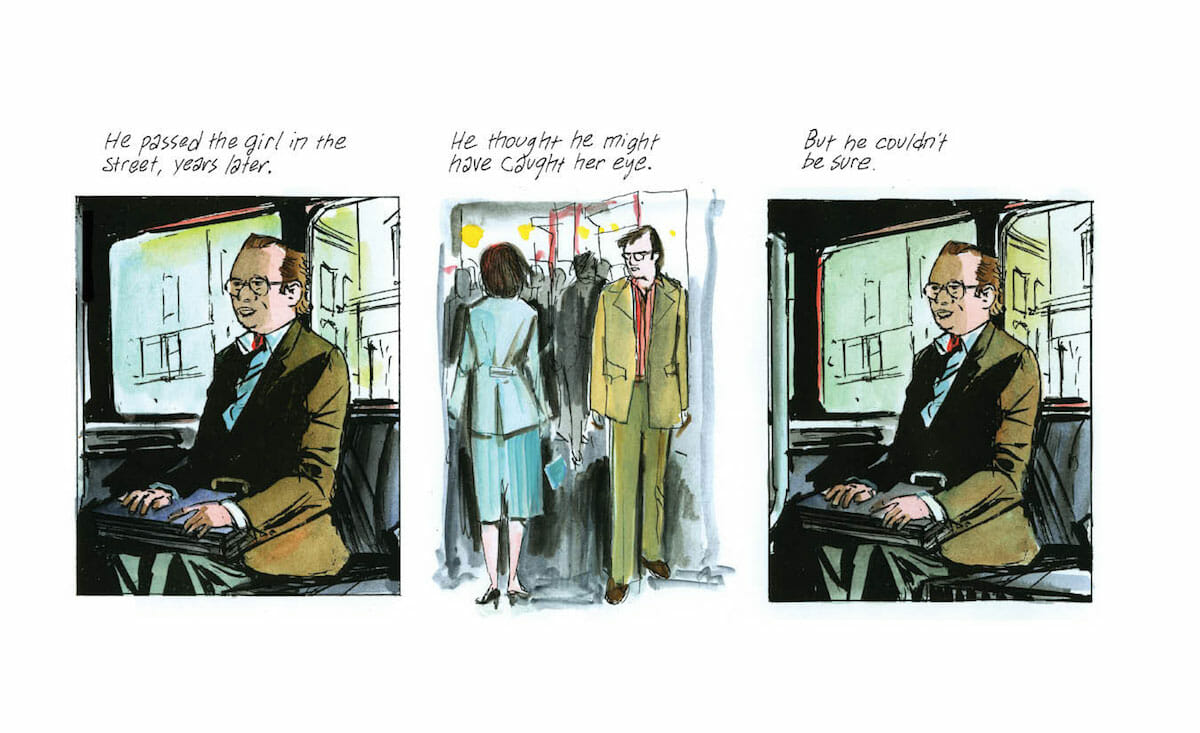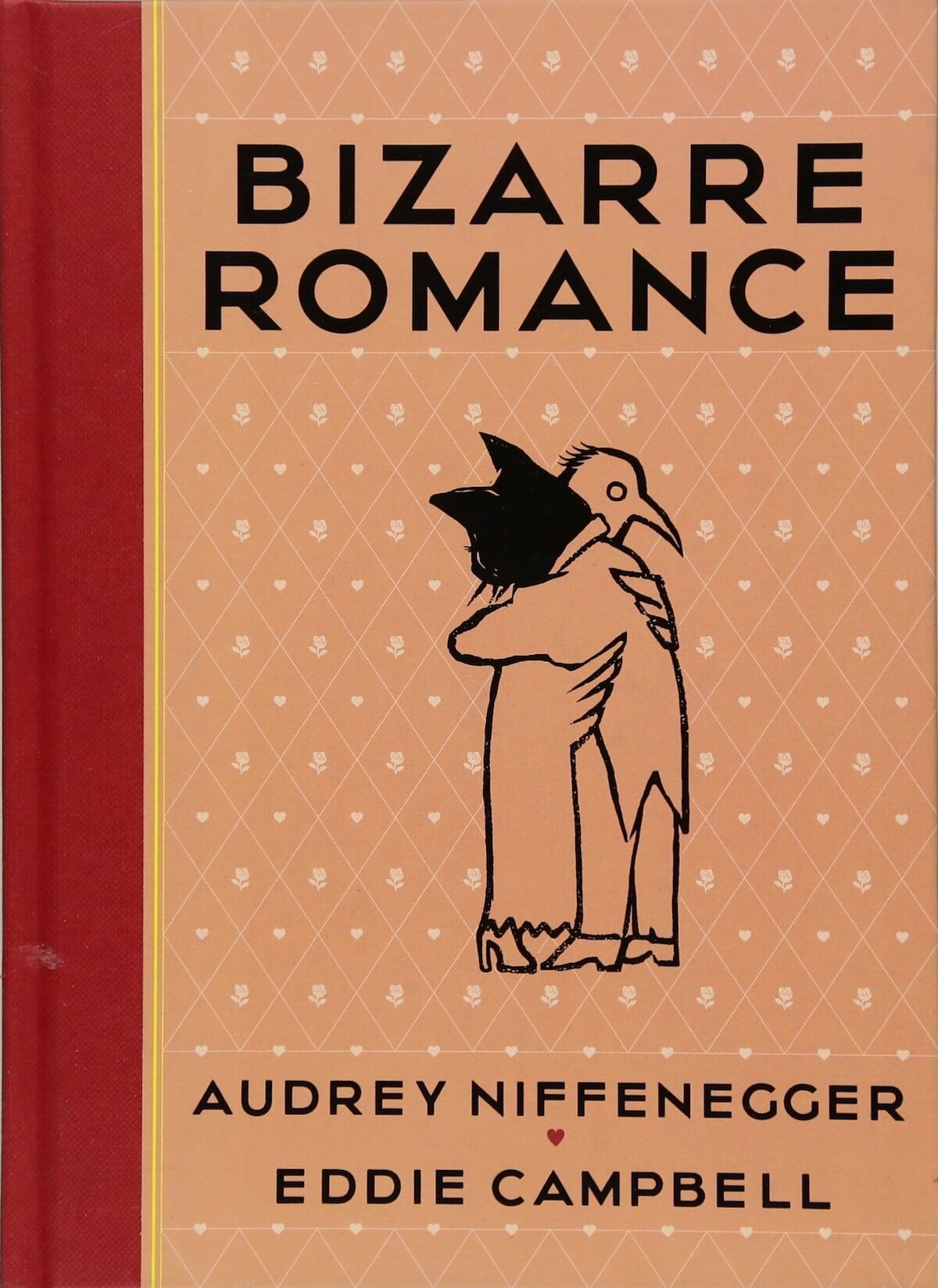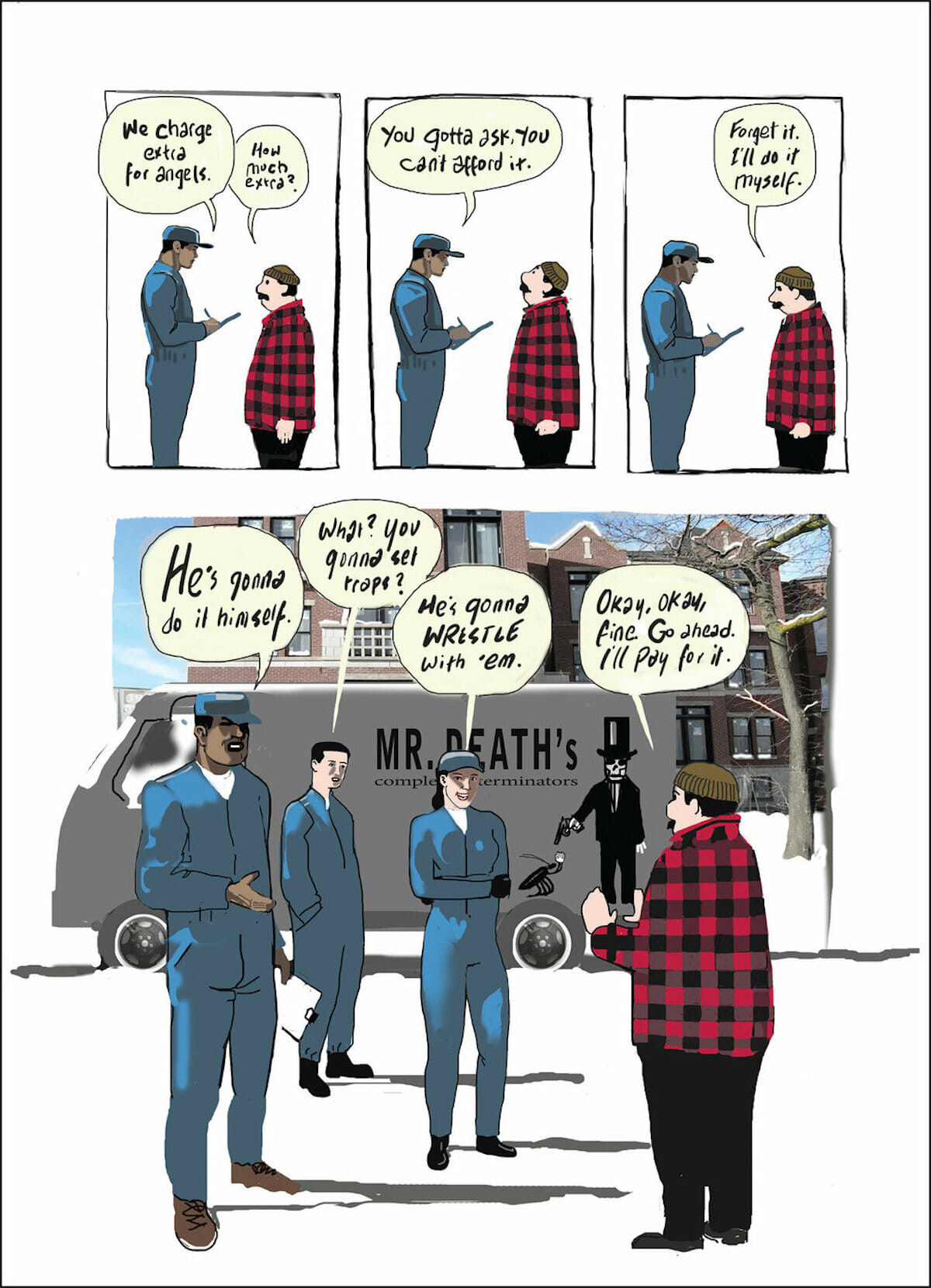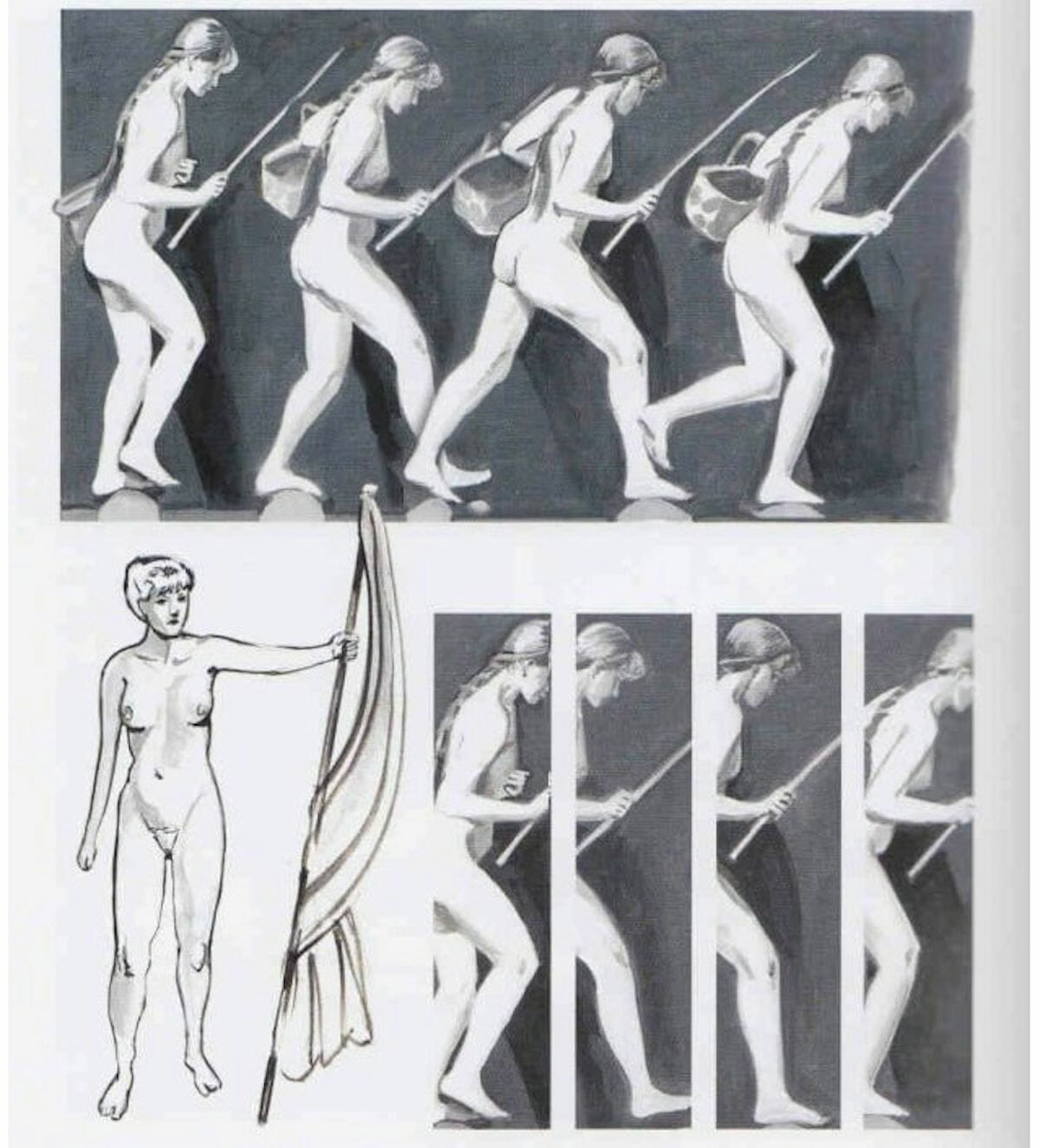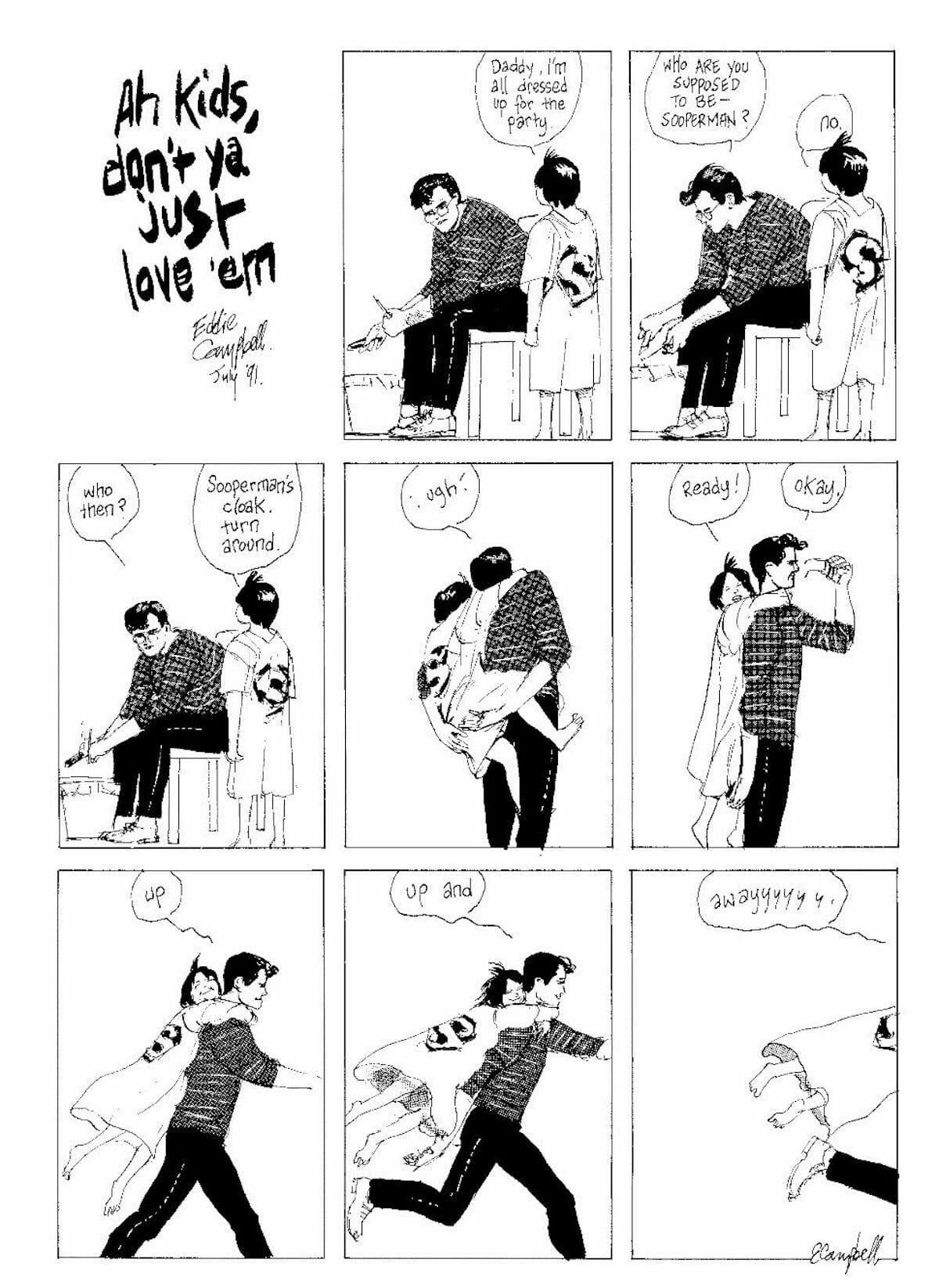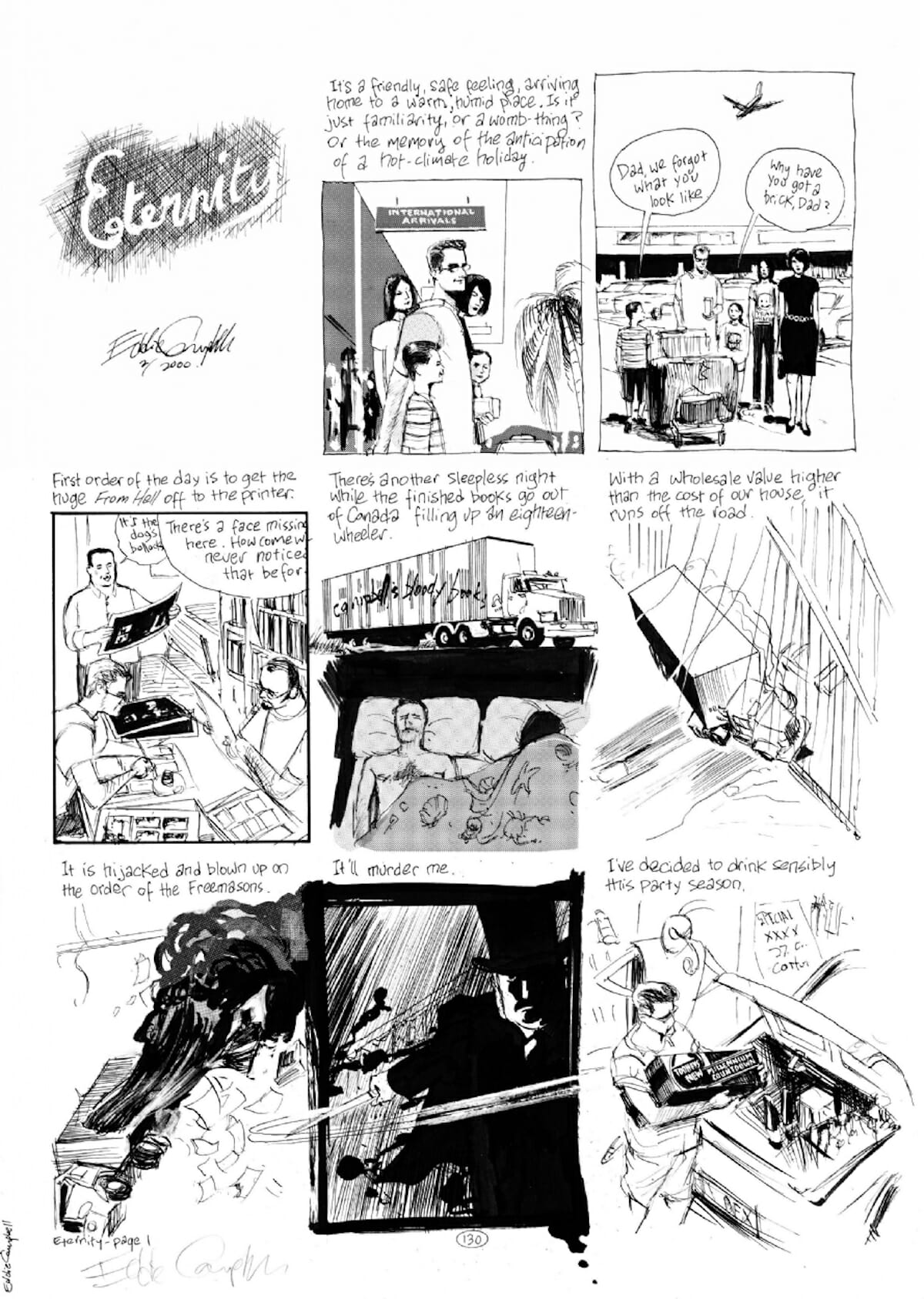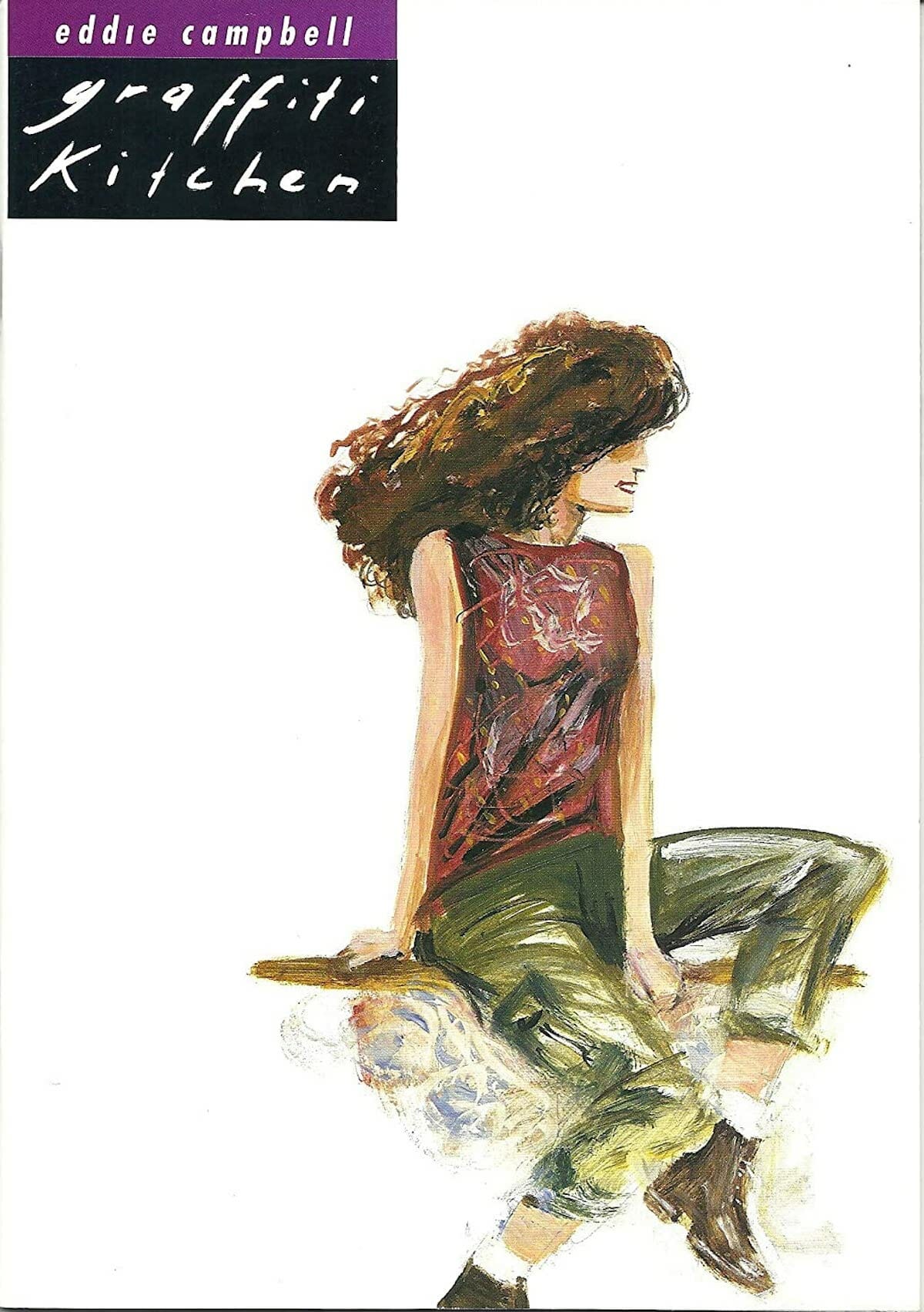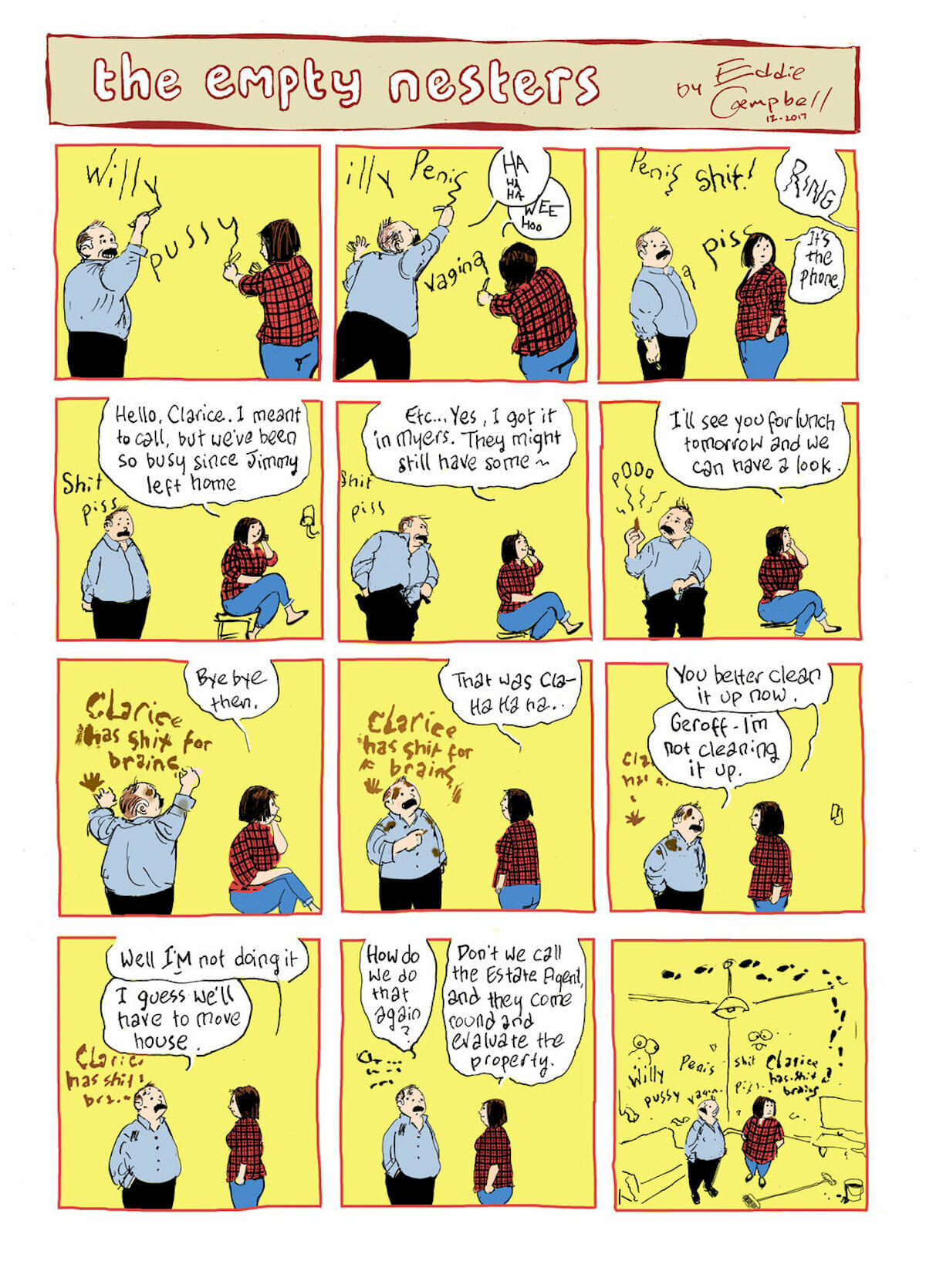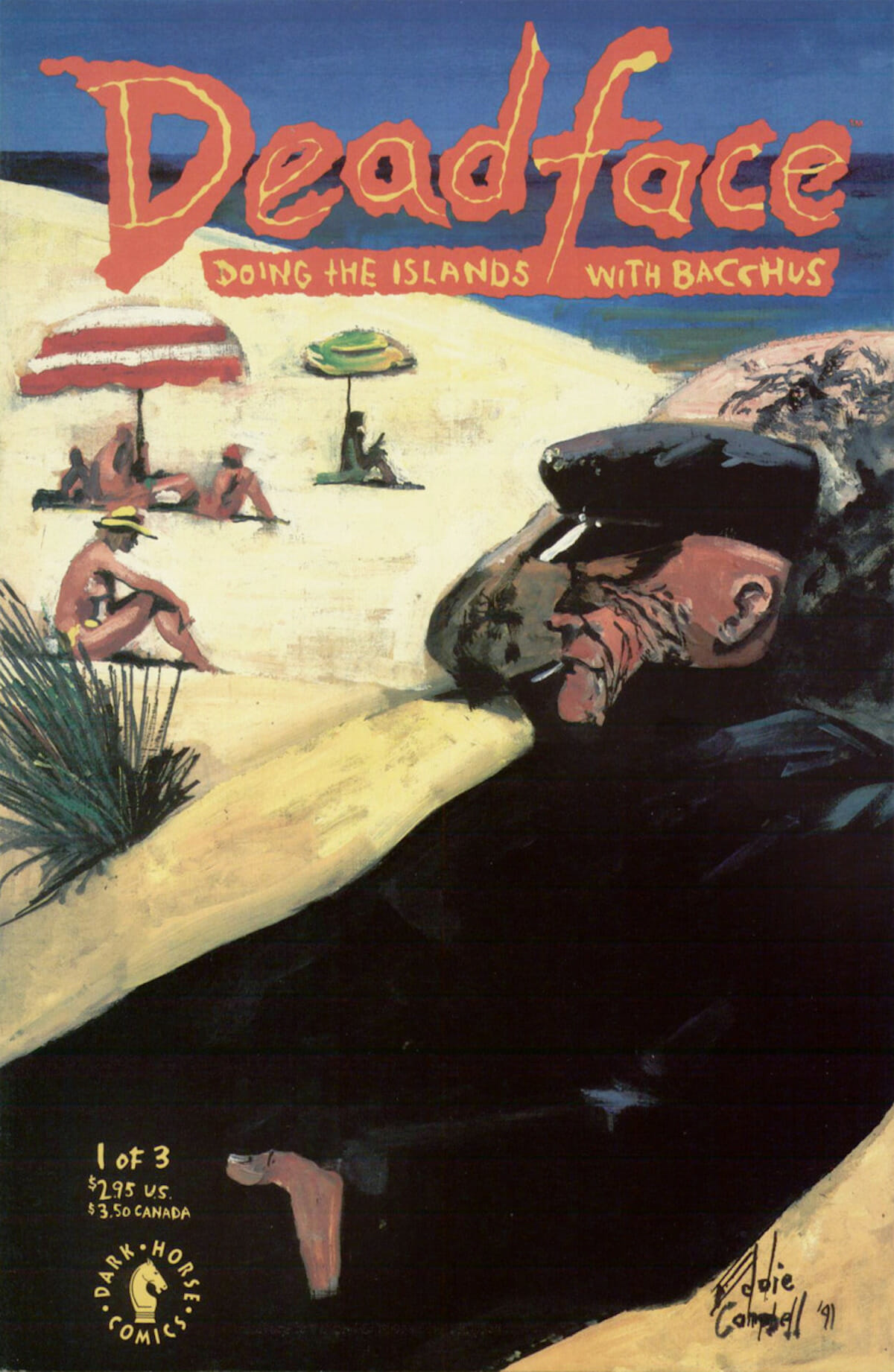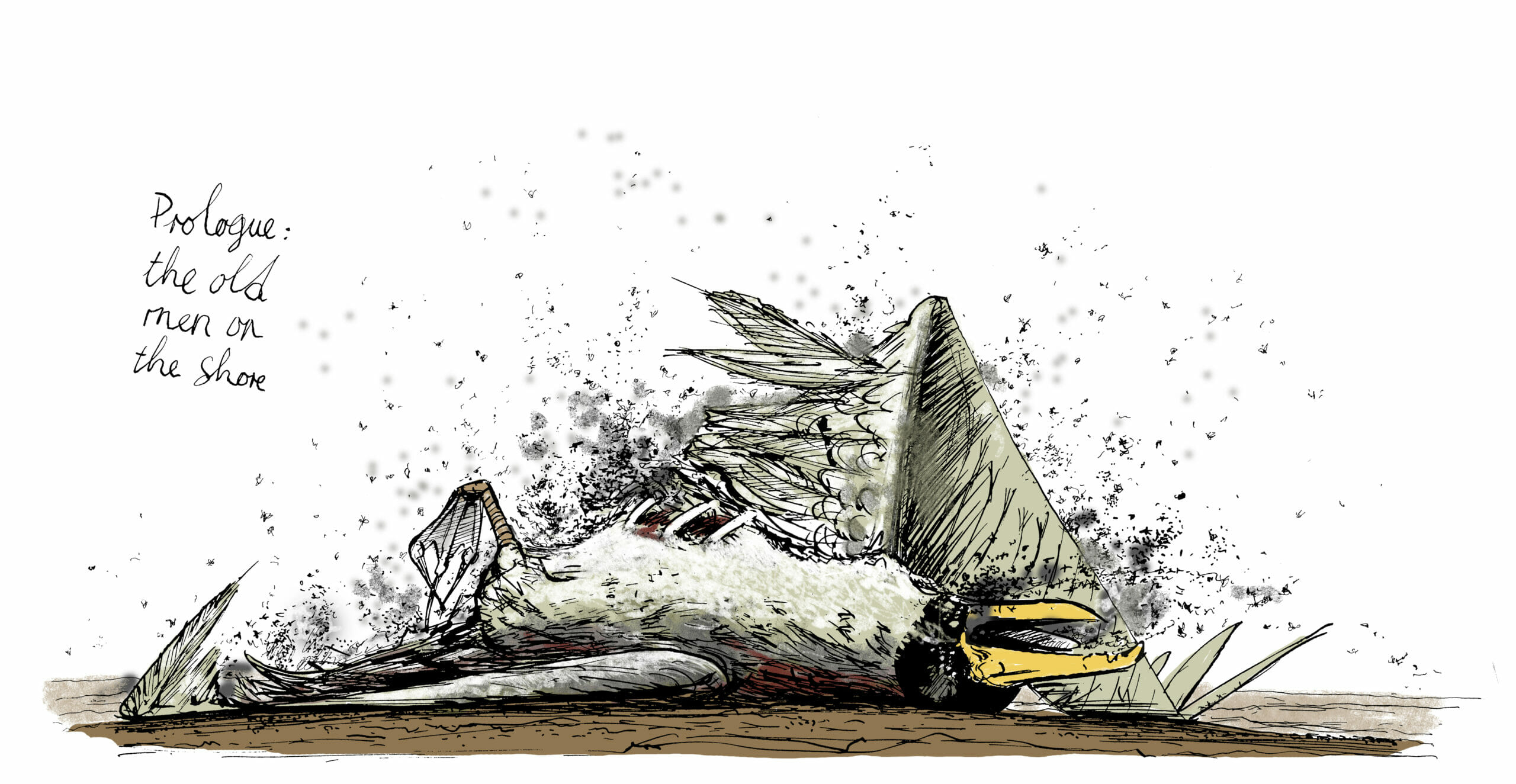This is the second portion of a conversation I had with artist and writer Eddie Campbell! If you would like to catch up and read the first part, you can find it right here!
——————
Can you tell me a little bit more about Bizarre Romance with your wife Audrey Niffeneggar? This isn’t a book that I feel like gets talked about nearly enough. And I can’t help but laugh about the blurb you have on your blog about the origins of it being a writer asking an artist to collaborate, the artist saying “no, darling”, and then they collaborate anyway.
I’m really glad you brought it up, actually, because I really love the book. It’s really great. Every story is a different experience so I tried to do each one in a different style and different technique. How it started, however, was…well….I married Audrey Niffeneggar, the novelist who wrote The Time Traveler’s Wife. She’s very famous! She’s very famous in that realm — not famous in the comic community. Just flat out famous. In fact, I’ll tell you — one time I was having dinner with Audrey and with Chris Ware. It was me, Audrey, and Chris and someone on the other side of the restaurant walked over to our table with an autograph book. I kept thinking “Oooh. This is interesting. Who do they want?” Turns out it was Audrey. It was Audrey. He didn’t have a clue who me or Chris Ware were, but he told her just how much he loved her books and apologized for interrupting our dinner! [laugh] Had no idea who the fuck we were. We were nobodies! She’s so much better known. She’s sold millions of her novels.
They are ridiculously good, to be fair. I loved The Time Traveler’s Wife, too.
Aren’t they wonderful? And they’re supposed to be making a TV series out of The Time Traveler’s Wife. Steven Moffat is doing it. The guy who did Doctor Who and Dracula. But anyway…The Observer magazine — The Observer is The Guardian’s Sunday paper — their Sunday color magazine they decided they were going to do one issue that was going to be all comics. This is a color, glossy magazine and they wanted it to be all comics. But the theme they had was that they were teaming novelists with comic book artists. So my friend Paul Gravette who wasn’t even really involved with it, told them “You should do Eddie and Audrey! They’re already married — a comic book artist and a novelist!”
I can’t remember who the other choices were anymore. This was eight years ago so I’ve forgotten who there was since…but there were five or six stories in it. We did a little five pager. We did another one for an IDW book called Shadow Show inspired by the stories of Ray Bradbury. It was originally done as a prose book but they decided to a comic book version of the same one. Audrey had written a story for that and I adapted that story into comics for the anthology. So by then we had two stories and honestly, once you have two stories the obvious conclusion is to just go a little bit further and have a whole book. So we used the two we’d done to sell the idea of doing a collection in which I would adapt Audreys short stories into comics. That’s kind of the origin on that. There’s just a lot of different stylistic thing going on there.
It was really wild as a reader. I thought that I knew all of your artist tricks by now and had grown accustomed to seeing you very distinct art style and then I pick up Bizarre Romance and it was genuinely surprising! Like, “Oh! What a nice new thing! Am I sure Eddie Campbell’s name is actually on the cover?”
[laughs] My favorite one is the one that’s based on Eadweard Muybridge’s model, Blanche Epler. We know some of the names of his models but Blanche was always his favorite. He did all of those continuous photograph things and they’re all nude. He even posed for one of them himself just to show that he wasn’t being a voyeur. He put himself running in the nude with his beard flapping around.
[laughs] That’s dedication to the craft and to not being creepy!
[laughs] It’s incredible funny. And it ends with a complete fabrication of Blanche getting out fo bed from 3 angles and 36 pictures, which was a huge challenge. I liked the challenge of making it look real even though it doesn’t really exist. I had copied things that did exist and tried to pull off the trick of creating something that would pass off as the real thing. That was the attraction of the story for me. I really enjoyed doing it. It was particularly fun because it was a very, very short written piece that turned into an 18-pager [laughs] If it was just the text it would have been one and a half pages but I expanded it into 18 pages of comics. Whereas there were ones that were around 24 pages of text and…I just can’t see that. I can’t think of that. To do that properly would take 100 pages of comics, so we printed those as text stories and I did some spot illustrations instead.
You talk about this like it really was something of an experimental challenge for you as well. Did that make it more fun?
It was meant, more than anything, to just be fun. I just wanted it to be great fun. There’s another story of a middle-aged guy who’s got angels in his loft and he’s got to call around the exterminators to get the angels out.
That’s one of my favorite stories from the collection! It’s hilarious.
There’s some full page pictures in there, too. There’s one I’ve done like a medieval manuscript and another where a man’s busting out the top of a roof, throwing one of the exterminators into the air while the closeup is the fire brigade arriving [laughs] It’s just fun! It was fun just…making pictures.
There’s a joy is going back to making something simply fun like that, I’m sure.
Well it’s…it’s actually one of the things I find difficult about comics these days. I feel like artists aren’t as interested in just making pictures. I think people are so concerned about making some kinetic thing that is really just fragments of pictures. What you see is two people arguing but there will be maybe a bit of finger-pointing and a bit of an eye and a bit of a wide mouth. But if you look at each individual panel, it doesn’t really say anything. I have a rule that every picture should contain the entirely of the drama. Have you ever read the stories of Bernard Krigstein?
Sure, one of the old old comics guys, yeah?
Right, he was one of the guys from the 1950s. But he thought that Eisner has disrupted the integrity of the picture by breaking it down into fragments. That has become the way of telling stories in comics. It’s bit and pieces and then very few answers because…well it’s just drawing a picture. If I’m ever in a position of giving advice or teaching or whatever, I always try to drum that home. At convention tables if you look at something that someone is working on and it’s this frenetic, flutter of partial images of somebody doing something or somebody doing something. But if you look something out of the page and away from the rest of a context of anything else, it’s almost impossible to know what’s going on.
Actually — and here’s a short little story — I was reading a comic book to my son many, many years ago when he was about three or four years old. But we he said to me “Who’s that man shooting at? Who’s the guy shooting the gun?” — it was a Batman comic or something like that — and I told him “He’s shooting the man in the other picture”. He mulled that over for a bit and then said “Why would he shoot a man in a different picture?” [laughs]
Trust kids to tell the truth on things like that, right? “But why does that guy need his whole other picture?” [laughs]
[laughs] Well, extrapolating from that, couldn’t there have been someone in the same picture to shoot? He was trying to shoot someone in a picture over there! It was really hard for my son to follow that logic. That made a really big impression on me because, at the time, we were all wailing about the fact that the audience for comics was getting smaller; what used to be a mass medium has turned into us trying to sell books to two or three thousand people instead of the hundred thousand it used to be. So I thought, well, it might be because there’s such a muddled way of explaining things and tellings stories.
We think we’re directing a movie where the picture should just be like a frame from a movie, but it doesn’t have to be. We have to explain things more. And sure, at the time I thought “ah, he’s only four”; but I’ve seen grown people who can’t understand how to read these things or make sense of the pictures in front of them. I understand that, too, because I look at some comics pages and can understand why no one can make sense of them because some artists just don’t quite understand how to communicate the essence of his idea. It’s just all over the place. But I’ll always think of that time reading comics to my son.
Kids are a great gauge for that kind of thing though. Seriously! They don’t mince words at all. I’ve got an eight year old who’s just now getting into reading comics on his own, and I’ll tell you — some of these young adult and children’s comics can give you the context, joke, punchline, and plot progression in four panels better than some “adult” comics can in an entire twenty-four page issue.
A lot of kids books are so much more attractive than comics right now as well. Have you ever seen the work of Sarah McIntyre?
Oh, sure! I think we’re even got some of them here at home.
She’s done some gorgeous work, hasn’t she? You never have trouble figuring out what’s going on in her picture books. It’s all right there! You don’t need to go to another whole picture to find out what’s going on in the one you’re looking at. [laughs] So I’ve always been aware of that. Sometimes in Alec or From Hell, too, if there’s two people having a conversation then the two people are in every picture on that page. If someone’s saying something, you know who they’re saying it to because the other person in in the picture. Sometimes I might do a close-up but…it would be because we’re trying to get the momentary perspective of inside that person’s head. I would never do a close-up unless there was some essentially need for it.
If you just have two people having a conversation, you don’t need any funny angles or cut-aways. You just draw it and make the whole picture something compelling. Like…what are they doing with their hands? What is the body language telling us? You need to see the whole figure to know what the body language is telling you! You need to be able to compare it to the figure in the previous drawing. That’s a lot of technical stuff though. I don’t usually go so technical in these things. [laughs]
It’s interesting though! Since it’s a rarity to hear you talk so candidly about the more technical aspects of making art, it’s wonderful to get your take on the state of things or hear how your brain ticks about this stuff. You have such strong opinions on the state of comics though so I have to ask — do you ever get the urge to get back into doing comic book work?
Ermmm. Well, like I said earlier, From Hell has been calling out to me for all of these different things to get fixed and I finally came to an agreement with a publisher to make that happen. I have been toying with the idea though. Do you remember my book The Fate of the Artist?
Yeah, of course. The one about your disappearance [laughs]
Yes, that one. It was an autobiographical novel in which the author doesn’t appear. I was thinking about doing a follow up to that titled “The Second Fake Death of Eddie Campbell by Eddie Campbell”
OH MY GOD. THAT’S SPECTACULAR.
[laughs] I just keep piling up ideas that are floating around. I’ve not actually written anything down. At some point I need to make an actually start on it. I think that would be my next book.
By the third one you’ll go so meta with it that it will just be blank pages.
[laughs] There’s a lot of funny ideas floating around in here. But we’ll see. I think we have to wait for COVID to get better for us all to get our lust for life back. It really feels desolate and diminished. I’m working up to it, I think.
Look, you said earlier that if you write another book you’re worried that no one is going to read it but I’m damn near jumping out of my boots in excitement over here.
[laughs] I’ve actually got a whole other book that’s finished! It’s been finished for a while and I’ve been working on negotiating with a publisher but its…uhhh. I blame it on the COVID. But it’s another arts that involves loads of restoration of old cartoons. It’s about America’s first great woman cartoonist, Kate Carew. Are you familiar with her?
I became familiar with her after our last conversation, funny enough. You talked to me about this entirely off the record at San Diego!
It was just a year and half ago! Well yes! So the book is now finished [laughs]. I’ve gone over it so many times. It can’t get any more finished and if I touch it any more I’m going to completely wreck it. But it’s finished and ready to go and just…it’s difficult right now.
A lot of publishers are kind of treading water right now with the state of things.
Yeah, exactly. But hopefully soon! I have been working, though. I just haven’t done any new comics in a long time. The think the last few comics I did were the ones that I made for my website called “The Empty Nesters”. They’re very rude [laughs]
They’re hysterical though!
There’s no nudity or anything but they are a bit shocking. If someone is looking for some new work of mine, they’re probably the funniest thing I’ve ever written. [laughs]. They’re a bit naughty. The six of the comics are about what a couple does when they find the kids all grown up and out of the house and are left alone. What do they do? Well, it’s not exactly what you think. It’s honestly probably the last thing that you’re thinking [laughs]
I think most people might learn a few new words or phrases after reading them.
They’re very easy to find on the website. And I just finished coloring those, too! They were black and white things that had been an Australian magazine about ten years previously. I colored them specifically for the website to help promote things. Coloring has this amazing effect on things, doesn’t it? I finally figured out how to color on the computer for the 20th Anniversary of From Hell. Wait no…no, I tell a lie. The first thing I really learned to color on the computer was The Lovely, Horrible Stuff, my book about money. But there’s still a lot of the essentials drawing. It’s all still just ink on paper.
There’s one story in Bizarre Romance — the one about Rose Red — but that’s the only story that’s black ink drawings in the traditional comic book way. It’s a funny think working traditionally though because…you can paint something one color and it will never come back printed that same color. Whereas if you make a color not he computer, you have at least a sliver of a chance that it’ll come back the color that you wanted. It’s because printing goes straight from the digital file to the printing plate — no photographic negatives. Previously, there were too many steps where things could get mixed up and go wrong. I used to do painted covers for Bacchus, for instance, and I’d say to the printers “Why are these coming out so muddy? And he told me that they always over-ink the black because comics always want the juicier black! Yeah, okay, but not with a painting. [laughs] But when they separate the colors, there’s always black in everything. Theres’ red in everything. You might have a blue sky with 2% of red and 2% of yellow. But there’s going to be red, yellow, black, and blue in everything. So if they push the black up, everything goes darker and goes muddy and horrible.
The only way to avoid that really is to have colors separate from black like they do in comic books. The black is always on a separate plate and then they do the other colors on a whole other thing. Anyway. When you’re painting it it’s really hard to get it to come out right at all because printers really want to turn the black up. That’s why I do all of my coloring on the computer now. It’s the only way to keep it just right.
What was the last painted thing that you did for comics then?
Oh goodness, I think probably The Playwright? And that was in 2012. But I got to use these lovely, juicy watercolors. Not a single page that came out exactly right. I think I can live with that now though. I stopped crying into my pillow after a couple of hours. It’s as good as it’s gonna get [laughs]
Well you finally have some space to appreciate it. You’re never going to see the brilliance if it’s fresh and new and not exactly what you wanted it to be. I’m sure a nine-year gap probably does a world of good in that sense.
There’s a famous quote. Something about it’s not a mistake your assistant made or that your typist made, but that you made, and you think about this as you sit in abject horror that this thing has gone into print. But after a time, you learn to live with your book [laughs]. Not like a son or daughter, but like the son or daughter of your first wife, long divorced [laughs] It’s something like that. I can’t quite remember. In other words, you get enough distance and you can live with it. It’s not that close to you anymore and it won’t upset you when you look at it.
You always imagine that when you’re going to be an artist or a writer and you get your book and you’re gonna be so happy. “Oh! I’m going to be so happy to see my book! My book! In print! I’m going to see all of my hard work!” And then after a few times you realize that it’s an entire tragedy every time. Every single time! [laughs] You finally see your work in print and all of the mistakes and problems you go…well, god, how can I live! What can do and how do I live with this! How can I carry on in the world! Why did no one tell me! But we live with it and it can still make people really happy. So…I guess I can’t be too bothered!

